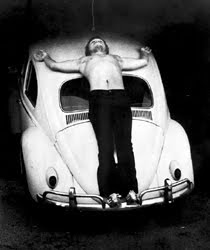Artists Among Poets - Performance Art
In performance art, the actions of an individual or a group at a particular place and in a particular time constitute the work. Performance art can happen anywhere, in any venue or setting and for any length of time. Performance art can be any situation that involves four basic elements: time, space, the performer's body and a relationship between performer and audience.
Genres of Performance Art
Performance art genres include body art, fluxus, happening, action poetry, and intermedia. Some artists, e.g. the neo-Dadaists, prefer to use the terms live art, "action art", intervention or "maneuver" to describe their activities. These activities are also sometimes referred to simply as "actions".
Trans-fixed - Chris Burden, 1974

Cut Piece - Yoko Ono
Happenings
Happenings can be a form of participatory new media art, emphasizing an interaction between the performer and the audience. Breaking the fourth wall between performer and spectator, it replaces criticism with support. For some happenings, everyone present is included in the making of the art and even the form of the art depends on audience engagement, for they are a key factor in where the performers' spontaneity leads.
Later happenings had no set rules, only vague guidelines that the performers follow based on surrounding props. Unlike other forms of art, Happenings that allow chance to enter are ever-changing. When chance determines the path the performance will follow, there is no room for failure. As Kaprow wrote in his essay, "'Happenings' in the New York Scene", "Visitors to a Happening are now and then not sure what has taken place, when it has ended, even when things have gone 'wrong'. For when something goes 'wrong', something far more 'right,' more revelatory, has many times emerged".
Wolf Vostell, Joseph Beuys, Nam June Paik, Charlotte Moorman, 1966
The art defines itself by the fact that it is a unique, one-time experience that depends on audience response. It cannot be bought or brought home, which entitles every Happening artist to a sense of privacy.
Kaprow’s piece 18 Happenings in 6 Parts (1959) is commonly cited as the first happening, although that distinction is sometimes given to a 1952 performance of Theater Piece No. 1 at Black Mountain College by John Cage, one of Kaprow's teachers in the mid-1950s.
Cage stood reading from a ladder, Charles Olson read from another ladder, Robert Rauschenberg showed some of his paintings and played scratched phonograph records, David Tudor performed on a prepared piano and Merce Cunningham danced. All these things took place at the same time, among the audience rather than on a stage.
Happenings flourished in New York City in the late 1950s and early 1960s. Key contributors to the form included Carolee Schneemann, Red Grooms, Robert Whitman, Jim Dine Car Crash, Claes Oldenburg, Robert Delford Brown, Lucas Samaras, and Robert Rauschenberg.